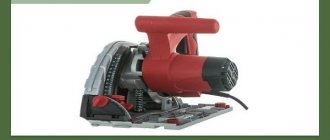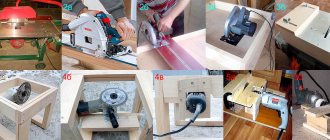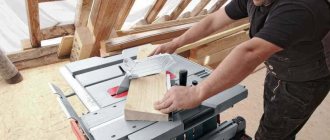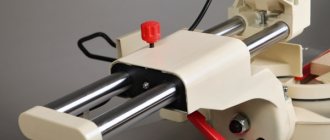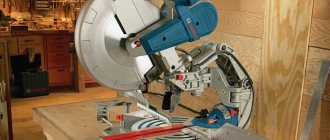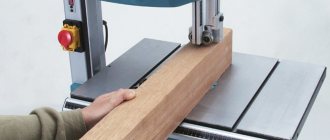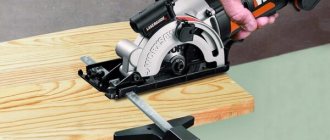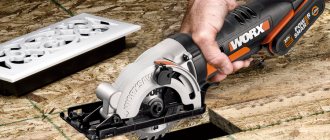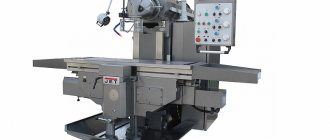Sometimes we learn about world innovations from the hands of suspicious traveling salesmen. This is exactly the story that happened with mini circular saws, which about five years ago began to actively promote themselves in the Russian Federation under the Rotorizer brand. Similar to the “unique” Renovator, this turned out to be one of the Chinese brands of a well-known, albeit young class of power tools. Let's look at “multi-saws”, “universal saws” and “mini-circular saws” in more detail.
Market request for a new class of instrument
Circular and plunge-cut saws have been on the market for almost a century; grinders are used a little less. For the most part, this is a professional tool, and the tool is needed both at home, for DIY, and in creative workshops with small volumes. The "housewife" market demanded a new product - a small and convenient saw for household use and cutting. Grinders are too dangerous, circular saws are too heavy, and jigsaws, which are still considered a universal home cutting tool, are too sloppy.
However, manufacturers moved towards “home” use one-sidedly - with the same dimensions and weight, components became cheaper, reliability was sacrificed (hello to the plastic elements of green Bosch gearboxes), and power was reduced.
The first sign of a new class of “home” tools is considered to be the Rockwell company, which in America in the 2000s released several home mini trim circular saws - small circular saws with a layout reminiscent of a grinder, light and simple, safe due to the solid casing and powerful (500-700 W ), so that there are enough universal abrasive discs for wood, metal, and tiles. Such a tool was promoted, by the way, through TV Shop.
Within a few years, universal saws appeared in Europe under the Worx brand (merged with the Rockwell holding), and the Chinese, who produced the originals, released a number of devices “based on them.” European brands are several years behind. The first release was from AEG - a smaller version of the grinder, Sturm and Dremel released their versions two years later, and Sturm! is a classic budget tool, and the Bosch division has remained true to its “creative” traditions - the Dremel DS20 has more in common with the engravers of this brand than with any saws or grinders. By the way, the “green” Bosch had a universal XEO cutter, but this is the brother of the IXO line and it is difficult to classify it as a universal saw - it is too small and weak.
Following the leading brands, others followed - from noname Chinese with honest and not very copies to alterations in the style of IP and Bort. By 2013, the market for universal saws had developed, and now, 3 years later, separate sections of catalogs with the names “Universal saws” and “Mini circular saws” are beginning to appear, where there are none - you can always look for saws with blades smaller than 85 mm - now this separate niche with separate layout.
Mechanical and linguistic subtleties
It's worth starting with the name itself. The word rotoraser, by which the instrument is designated on English-language sites, is clearly a combination of two: rotation - rotation, and raze - to demolish, reduce, destroy (although it is possible that it also comes from razour - razor). As you know, according to the rules of the English language, such a word should be read as rotorEizer, and not as rotorEizer. Now, if there was a rotorizer (rotary mill), then the word should be translated as rotorizer. The fact that the rotorizer is a saw is indicated by the subsequent prefix saw.
Now let's talk about the operation of the rotary saw. The principle of operation is simple: the tool is installed with a steel sole on the surface to be cut, after which the electric motor is turned on. By moving the rotorizer over the workpiece, we cut it in depth (depending on the device settings) and length. If cutting produces a significant amount of chips (cutting MDF boards or wood), then the inlet pipe of the vacuum cleaner is connected to the casing. For small cuts, or for working with metal, the presence of a vacuum cleaner is not necessary.
Some technical capabilities of the rotorizer:
- Cutting metal up to 2 mm thick (which is not clear, because both aluminum and steel are metals, but their strength is significantly different).
- Disc diameter - 54.8 mm.
- Drive power - 600 W.
- The saw blade speed is 3400 min-1.
- Weight - 1.2 kg.
A standard set of saw blades for a rotorizer consists of three pieces - for cutting wood, metal and ceramics.
Key models
Let us briefly list the key models of mini circular saws on the market:
- Worx WX424 is the founder of the class of tools in Europe. Exclusively household, but high-quality and popular option;
- Dremel Saw Max DSM20 is a high-quality and versatile version of a universal saw with a high price;
- SKIL 5330 LA is a budget version of a mini circular saw from the Bosch concern;
- Sturm! CS5060 is a worthy representative of the Chinese brand for home craftsmen;
- Makita HS300DWE is a mini-saw that differs from competitors by positioning an additional tool for professionals;
- Rotorazer Saw is a product of good marketing from a budget Chinese manufacturer in Russia.
These saws will be discussed in more detail in a future article. There are plans to make some kind of rating of an instrument of this class and give an assessment of each of the mentioned models.
Basic equipment
The basis of the set consists of three sawing discs for different materials, which can replace each other
- Three sawing discs for different materials , which can replace each other. Tungsten carbide is used for wood cutting. A high-speed steel disc is used for cutting metal. For cutting stone or tiles, a diamond-coated disc is used;
- Dust collector. It is very convenient to connect it to a regular home vacuum cleaner, so that the workplace is always clean while working. After completion of construction work, general cleaning of the premises is not required;
- Convenient case for storing and carrying the saw;
- Detailed instructions that will tell you how to properly use the tool and its attachments.
The possibilities when working with a Rotorizer saw are very extensive. You can either simply saw different surfaces or cut out complex parts with many angles.
Design, its pros and cons
The layout of the mini-circulars has already taken shape:
- Oblong body;
- Vertical small disk;
- A guard that completely covers the saw blade.
Wiring, power and adjustment buttons are similar to angle grinders. Rotation is driven through a small gearbox, which is usually the weakest point of the design - it is susceptible to overheating and does not like heavy loads. Some models have speed control, but this option is reflected in the price.
Almost all representatives of the class have adjustment of the cutting depth, which is realized by simply tilting the lever with marks on the protective body. The lever changes the position of the casing, extending or hiding the rotating disk.
Actually, all discussions of the pros and cons of universal saws come down to the tasks that people want to solve with their help. To put it simply, compact saws are only good for specific tasks. This:
- Cutting sheet materials - laminate, fiberboard, chipboard, OSB up to 20 mm deep;
- Sawed (hence the American name trim circular saw) small metal elements, for example, thin reinforcement or corners of corrugated sheets;
- Household cuts on hard materials - brick, stone, tile in minimal volumes.
Branded “rotorizers” have enough power - from 600 to 800 Watts, which is quite comparable to the initial models of professional angle grinder lines. However, the operating mode must be intermittent - the gearboxes overheat and require rest, especially when working with complex material.
Total advantages:
- Compact and lightweight tool;
- Convenient to use with 1 hand;
- Relatively safe;
- Replaces several tools (saw, cutter, jigsaw).
Minuses:
- Poor output and risk of overload;
- “Zoo” of consumables and their high cost;
- Narrow, “home” use;
- No accessories such as guide rail or under-table mounting bracket.
I personally really like the idea of a mini circular saw. After all, with low productivity, it takes up little space, replacing several bulky appliances, and ease of use allows even an untrained housekeeper to reveal its “masterful” potential.
Installation and preparation for work
The kinematic diagram of the saw is simple. The movement from the electric motor is transmitted to the gearbox (the gear ratio of which varies within 1.5...4), and from it to the shaft with the disk. For precise positioning of the disk on the surface being cut, its movement is carried out in the guide groove of the sole.
The tool consists of the following nodes:
- Base plate.
- Protective casing with a fitting for the dust collector.
- Cases.
- Measuring ruler and calibration scale.
- Gearbox.
- Cutting disc shaft.
- Locking lever.
- Control unit.
- Power cord.
The rotorizer also comes with a hose for removing chips. To adjust the saw and fix its individual elements during operation, a setting screw is used. The saw body is made of impact-resistant plastic.
Before turning on the rotorizer, perform the following operations:
- Installation of a limiter that determines the depth of entry of the disk into the workpiece material, for which an adjusting screw is used. The depth must exceed the thickness of the workpiece by at least 1...1.5 mm;
- Using a hose, connect the dust collector to the protective casing. To do this, use a clamp or construction tape;
- Securing the workpiece on the work surface (you can use a vice or any screw clamp);
- The suitability of the selected saw blade for the material being cut is checked.
A total of three discs are included in the kit: a steel disc with 30 teeth, designed for working with laminate, metal and plastic, a hard alloy disc of type VK - for cutting wood and layered materials, and a disc with surface diamond coating, intended for cutting ceramic products .
A little about circles (equipment)
Separately, the dimensions of the equipment should be mentioned. Every manufacturer seems to want to corner the market and create a new SDS-Plus or Morse taper for utility saws. True, so far nothing has come of it, and we have to choose from hundreds of articles, studying the sizes of the fits and the maximum radii of the circles.
Worx WX242 (Rockwell, Einhel) has a “classic” 76 mm diameter and 10 mm seat. They are “joined” by many budget manufacturers, for example Skil 5330. For higher-level models, the maximum casing diameter expands to 85, which corresponds to toothed saw blades for Makita and Bosch.
The Dremel DSM20 has a diameter of 77 mm and a mounting hole of 11 mm. In recent years, Bosch has launched the production of consumables and they are quite affordable.
Makita HS300DWE - 85 mm and 15 mm fit - about the slope of this manufacturer a little lower.
The Rotorizer, which is actively promoted on the Internet - generally has a unique equipment with a radius of 55 mm and a seat of 11.1 mm - you can only buy such discs from the tool manufacturer, and with a decent overpayment, and eleven-millimeter Dremel discs will have to be bored, which is not available to everyone.
An additional complication is the types of discs (materials). If for more or less standard seating there are both cutting and saw blades, then the Rotorizer has no saw blades at all (although the Chinese make all of them and new sets - quite like them with serrated ones), and the cutting blades wear out very quickly. The situation is the opposite for Makita - since the Makita cordless mini-saw was initially positioned as a small circular saw, there can be no talk of any cutting/grinding wheels. According to the rarity of a particular size and material, the quality drops and the price rises. In sum, there are only problems with this non-standard equipment.
User reviews
If you read reviews from rotorizer owners on unofficial sites and forums, you will find the following:
- During prolonged operation, the engine overheats greatly. This is understandable: high-speed engines do not have high torque, therefore, the force on the saw blade when cutting metal or thick fiberboard should not be accompanied by rapid movement of the saw along the surface. Otherwise, the speed will drop below the critical limit and the engine will burn out.
- The declared cutting depth - up to 12 mm - corresponds only to homogeneous surfaces of low hardness (wood, aluminum).
- There is no universal adapter for vacuum cleaners from different manufacturers. Therefore, perfect waste collection is not possible. Using a rotorizer is especially dangerous when cutting drywall, where fine dust is generated.
- An even cut is possible only with a small cut length. Already at 150...200 mm of the travel length, the cut turns out to be uneven. Structurally, it is impossible to provide a more rigid direction, since when the gaps are reduced, the danger of the disk jamming increases.
According to user reviews, it is advisable to use a rotorizer only when carrying out small chores.
Rotorizer operating instructions: how to use the tool correctly
Agree, many manufacturers write instructions for their products quite confusingly, which is why some problems and misunderstandings arise related to the operation of the tool. Instead of focusing on the basics, these instruction manuals contain a ton of junk. I’ll try to be a little prudent and tell you only about the main points, which you simply cannot ignore.
- Let me immediately remind you to check the completeness of the new tool, the presence of a warranty and other obligations of the manufacturer.
- Make sure that the dust extraction hose is securely fastened. Advice from practice - so that it does not interfere with work, it is better to tape it with electrical tape to the body of the tool. But you need to wind it where there are no ventilation holes. There is no point in abandoning this hose, as the chips are thrown out with great force.
- Safety first! Before changing the tool settings or changing the cutting blade, the tool must be completely unplugged from the outlet. You shouldn't rely on the button, since there have already been precedents for accidental activation. When changing the depth of cut, be sure to tighten all existing screws securely.
Otherwise, this tool is quite easy to use and unpretentious to maintain. Naturally, after finishing work, it is better to clean it and turn it on idle for a short period of time in order to remove any remaining dust from the system.
Rotorizer Operating Instructions
Advantages of the Rotorizer (for the Rotorazer Saw)
The rotorizer is an excellent alternative to a tile cutter
- Light weight about three kilograms with good power (400 W) and the required number of revolutions (about 4000);
- Eliminates dust even when working with materials that are “dirty” when cutting, such as drywall. Getting rid of dust occurs due to the ability of the saw to work in conjunction with a vacuum cleaner;
- Excellent cuts almost any material , including being an alternative to a tile cutter;
- Comfortable handle that fits snugly in your hand;
- Level cuts can be made both straight and curved, vertical;
- Suitable as a grooving tool.
